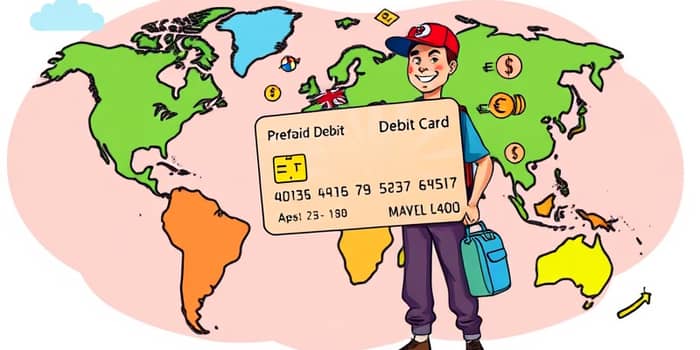
Travel planning requires more than booking flights and mapping out itineraries; it demands disciplined money management. Unexpected fees, fluctuating exchange rates, and the temptation to indulge can quickly derail even the most meticulously planned budget. A prepaid debit card designed for travel offers a proactive solution by letting you preload funds, track spending, and control your cash flow while abroad.
By locking in a spending limit and reducing exposure to fraud, prepaid travel cards can boost confidence and simplify your financial decisions. This comprehensive guide will explore how these cards work, their inherent advantages and limitations, and actionable steps for selecting and optimizing a prepaid debit card tailored to your next adventure.
A prepaid travel card is a payment instrument (often Visa or Mastercard branded) that you load with a specific amount before departure. It operates like a debit card, permitting purchases, ATM withdrawals, and online transactions without drawing from your primary bank account. Since transactions cannot exceed the loaded balance, there is no risk of overdraft or credit debt.
Most issuers support multiple currencies—ranging from five to over fifty—letting you lock in exchange rates and avoid volatile market swings. When traveling across borders, simply select the currency you wish to spend. The transparent fee structure and real-time transaction logs to monitor spending help maintain strict budget discipline.
In some regions, prepaid cards are so popular that as of 2018, 71.7% of debit cards in circulation were prepaid. Financial institutions, travel agencies, and online platforms all provide options, catering to diverse traveler needs from solo backpackers to family holidaymakers.
Preventing overspending is the cornerstone of prepaid card appeal. By setting a hard cap on available funds, travelers transform abstract budget targets into concrete spending limits. This approach proves especially valuable for vacationers prone to impulse purchases or those sharing expenses in group trips, enabling straightforward cost tracking without relying on mental math or post-trip reconciliation.
Security is enhanced because the maximum financial exposure is limited to the preloaded balance. If a card is lost or stolen, you can quickly freeze it via a mobile app or customer hotline. Unlike cash, which offers no recourse once gone, prepaid cards feature fraud monitoring systems and zero-liability policies, minimizing stress and financial risk.
With no credit line attached, prepaid cards eliminate the danger of inadvertently accruing interest or overdraft fees. You cannot spend beyond your means, and there is no credit check required to acquire the card. Families and young travelers benefit from simple setup, while seasoned adventurers appreciate the combination of spending caps and clear financial boundaries.
Prepaid travel cards are available through various channels: major banks, post offices, specialized travel card issuers, and digital fintech platforms. Minimum loads typically range from $30 to $100 AUD, with no upper limit except for provider-imposed caps. Currency support varies widely: traditional issuers may cover 5–11 major currencies, whereas providers like Wise offer access to 50+ currencies.
Reloading options include bank transfers (BPAY in Australia), debit cards, or in-app top-ups, often processed instantly. Fees for reloading vary from free to around 1% depending on the method. Some providers allow auto-reload when balances dip below a set threshold, ensuring that you never encounter a declined payment mid-trip.
Beyond basic spending, some cards grant additional features such as budgeting dashboards, spending notifications, and backup virtual card numbers for online transactions. These tools empower you to control every aspect of transaction history and receive alerts for unusual activity.
A clear view of fee structures aids in selecting the best card for your needs. Activation, loading, ATM withdrawal, transaction, inactivity, and currency conversion fees vary significantly among issuers.
Typical fees: Activation $0–$10; monthly inactivity $2–$5 after a year; purchases $0–$2 each; foreign currency conversions 0–3% for unsupported currencies. A thoughtful understanding of these charges can yield significant savings on multi-country trips.
Selecting the optimal prepaid card involves balancing costs, convenience, and currency coverage:
Adopt the following tactics to optimize your prepaid card experience:
While prepaid cards offer advantages, they are not a panacea. Some issuers charge significant inactivity fees after a year of nonuse. Daily transaction and ATM withdrawal limits may hamper access to larger cash needs in emergencies. Additionally, currency conversion markups may erode perceived savings if spending frequently in minor currencies.
Because these cards do not function as credit lines, they lack perks such as travel insurance, rental car collision waivers, or reward points. Furthermore, booking platforms and larger hotels often require a credit card for security deposits, limiting the standalone utility of prepaid travel cards.
Protect your prepaid card by enabling multi-factor authentication on the issuer’s mobile app and registering the card online. Store card details and emergency contact numbers securely, separate from the physical card. In case of loss, instant card blocking and expedited replacements mitigate travel disruption.
Consider splitting your budget across two cards or pairing with another prepaid or credit option. This redundancy ensures uninterrupted spending capability even if one card encounters technical issues or is temporarily frozen for suspicious activity.
Prepaid debit cards for travel budgeting provide a structured, secure, and debt-free way to navigate global expenses. By understanding fee structures, comparing providers, and following best practices—from setting spending limits to maintaining backup payment options—you can travel confidently without compromising on adventure or financial stability.
Embrace the power of well-managed funds, and let your prepaid travel card be the compass that keeps you on course, ensuring unforgettable journeys that stay firmly within your budgetary boundaries.
References













